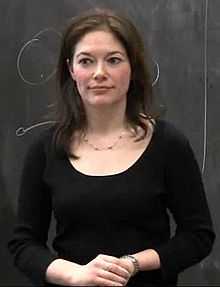Maria Chudnovsky
| Maria Chudnovsky | |
|---|---|
 | |
| Born | January 6, 1977 |
| Residence | U.S. |
| Nationality | Israeli-American |
| Fields | Computer Science |
| Institutions | Columbia University |
| Alma mater |
Technion, Princeton University |
| Thesis | Berge Trigraphs and Their Applications. (2005) |
| Doctoral advisor | Paul Seymour |
| Known for |
Graph Theory, Combinatorial Optimization |
Maria Chudnovsky (born January 6, 1977) is an Israeli-American mathematician.[1] She is a 2012 MacArthur Fellow.[2]
Biography
Chudnovsky is a professor in the departments of mathematics and of industrial engineering and operations research at Columbia University. She grew up in Russia and Israel, studying at the Technion,[3] and received her Ph.D. in 2003 from Princeton University under the supervision of Paul Seymour.[4] She moved to Columbia after being a Clay Mathematics Institute research fellow and assistant professor at Princeton.[3]
She is a citizen of Israel and a permanent resident of the USA.[1]
Research
Chudnovsky's contributions to graph theory include the proof of the strong perfect graph theorem (with Robertson, Seymour, and Thomas) characterizing perfect graphs as being exactly the graphs with no odd induced cycles of length at least 5 or their complements.[5][6][7] Other highly cited research contributions of Chudnovsky include co-authorship of the first polynomial time algorithm for recognizing perfect graphs (degree 9),[8] and of a structural characterization of the claw-free graphs.[9]
Selected publications
- Chudnovsky, Maria; Cornuéjols, Gérard; Liu, Xinming; Seymour, Paul; Vušković, Kristina (2005), "Recognizing Berge graphs", Combinatorica 25 (2): 143–186, doi:10.1007/s00493-005-0012-8, MR 2127609.
- Chudnovsky, Maria; Seymour, Paul (2005), "The structure of claw-free graphs", Surveys in Combinatorics 2005, London Mathematical Society Lecture Note Series 327, Cambridge: Cambridge Univ. Press, pp. 153–171, doi:10.1017/CBO9780511734885.008, MR 2187738.
- Chudnovsky, Maria; Robertson, Neil; Seymour, Paul; Thomas, Robin (2006), "The strong perfect graph theorem", Annals of Mathematics 164 (1): 51–229, doi:10.4007/annals.2006.164.51.
Awards and honors
In 2004 Chudnovsky was named one of the “Brilliant 10” by Popular Science magazine.[10] Her work on the strong perfect graph theorem won for her and her co-authors the 2009 Fulkerson Prize.[11] In 2012 she was awarded a "genius award" under the MacArthur Fellows Program.[12][13]
References
- ↑ 1.0 1.1 "Maria Chudnovsky Curriculum Vitae". Columbia University. Retrieved 2 April 2011.
- ↑ "2012 MacArthur Foundation 'Genius Grant' Winners". 1 October 2012. AP. Retrieved 1 October 2012.
- ↑ 3.0 3.1 Interview with Research Fellow Maria Chudnovsky, Clay Mathematics Institute, 2005.
- ↑ Maria Chudnovsky at the Mathematics Genealogy Project
- ↑ Mackenzie, Dana (July 5, 2002), "Mathematics: Graph theory uncovers the roots of perfection", Science 297 (5578): 38, doi:10.1126/science.297.5578.38, PMID 12098683.
- ↑ Cornuéjols, Gérard (2002), "The strong perfect graph conjecture", Proceedings of the International Congress of Mathematicians, Vol. III (Beijing, 2002), Beijing: Higher Ed. Press, pp. 547–559, MR 1957560.
- ↑ Roussel, F.; Rusu, I.; Thuillier, H. (2009), "The strong perfect graph conjecture: 40 years of attempts, and its resolution", Discrete Mathematics 309 (20): 6092–6113, doi:10.1016/j.disc.2009.05.024, MR 2552645.
- ↑ Chudnovsky et al. (2005).
- ↑ Chudnovsky & Seymour (2005).
- ↑ Minkel, J. R. (June 29, 2004), "Maria Chudnovsky", Popular Science
- ↑ "2009 Fulkerson Prizes", Notices of the American Mathematical Society, December 2011: 1475–1476.
- ↑ Lee, Felicia R. (October 1, 2012), "Surprise Grants Transforming 23 More Lives", New York Times
- ↑ Maria Chudnovsky, MacArthur Foundation, October 2, 2012.
External links
|